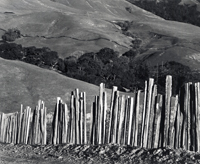
Edward Weston, Ranch, Old Big Sur Road, 1935; gelatin silver print; 7 9/16 x 9 7/16 in.; Collection SFMOMA, gift of Mrs. Drew Chidester; © 1981 Center for Creative Photography, Arizona Board of Regents
As part of its 75th anniversary celebration from January 16 through June 27, 2010, the San Francisco Museum of Modern Art (SFMOMA) will present The View from Here, a large-scale survey of California photography from the 1840s to the present. Organized by Erin O’Toole, SFMOMA assistant curator of photography, the exhibition comprises some 275 photographs drawn exclusively from the museum’s extensive photography collection and the Sack Photographic Trust. Throughout the anniversary season, SFMOMA will present a series of exhibitions under the heading 75 Years of Looking Forward illustrating the story of the artists, collectors, cultural mavericks, and San Francisco leaders who founded, built, and have animated the museum.
The View from Here explores the vitality and diversity of California’s indigenous tradition of photography from SFMOMA’s perspective. Founded in 1935, SFMOMA was one of the first museums in the country to treat photography as an art form on a par with painting and sculpture. The exhibition showcases the extraordinary depth of California photography in the museum’s collection, which was initiated with the gift of a group of Ansel Adams photographs the year it opened and has expanded in the intervening 75 years to include works by the major figures in the history of the medium.
SFMOMA’s long-standing commitment to photography reflects the city of San Francisco’s especially deep and symbiotic relationship with the medium. Since its earliest days, the city has been both a favorite subject of photographers as well as an incubator for photographic art. Following the 1849 California Gold Rush, the rapid transformation of the tiny hamlet of Yerba Buena (as San Francisco was formerly known) into a bustling city occurred just as the recently invented photographic medium began to flourish. The city’s development in the 1850s and 1860s was extensively documented in photographs that were used as propaganda to lure Easterners to the West. Since that time, photographic representations have shaped public perception of San Francisco, and, indeed, of California as a whole. Photographs have educated the American public about the realities of life in California, as well as propagated myths that have fueled the public imagination.
Beginning in the 1860s, when few Americans considered photographs works of art, San Franciscans framed landscapes of California’s scenic wonders by photographers such as Carleton Watkins, displaying them in their homes like paintings or lithographs. At the turn of the century, a thriving community of local photographers embraced the international style of Pictorialism, a soft-focus genre that emulated popular styles of painting, and argued for photography’s acceptance as a fine art. In the 1930s local modernists Ansel Adams, Imogen Cunningham, and Edward Weston banded together with other like-minded photographers to form Group f.64, which promoted photography as modern art and inspired generations of photographers to live and work in the Bay Area. With the founding of SFMOMA in 1935 and the establishment of photography departments at several area art colleges and universities in subsequent years, San Francisco became the thriving photographic center it remains today.
The View from Here surveys major trends in the history of California photography, looking exclusively at work by photographers who lived and worked in California for a significant period of their lives. Installed chronologically, the exhibition begins with the origins of photography in the 1840s, featuring daguerreotypes made around the time of the Gold Rush, some of the first photographs made on paper in California, and dramatic multipart panoramas of the city by Eadweard Muybridge and Carleton Watkins. The exhibition also includes photographs documenting the shocking devastation of San Francisco after the earthquake of 1906, and work by local Pictorialist photographers such as Weston and Tina Modotti. One gallery will be dedicated to the work of members of Group f.64, including Adams, Cunningham, Weston, and their peers. John Gutmann, William Heick, Dorothea Lange, Homer Page, and other modernists who were concerned primarily with chronicling life on the street are grouped together in a gallery, as are photographers such as Wynn Bullock, Edmund Teske, and Minor White, who shared an interest in exploring the metaphysical in their work. The exhibition also includes work by conceptual photographers of the 1970s, such as Robert Cumming and Lew Thomas; photographers whose primary subject has been the changing Western landscape, such as Robert Adams and Lewis Baltz; as well as work by contemporary artists such as Anthony Hernandez, Larry Sultan, Carrie Mae Weems, Henry Wessel, and many others.